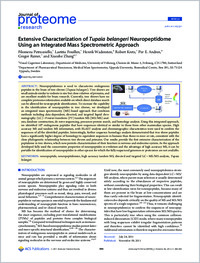Extensive characterization of Tupaia belangeri neuropeptidome using an integrated mass spectrometric approach
Université de Fribourg
- Petruzziello, Filomena Visual Cognition Laboratory, Department of Medicine, University of Fribourg, Switzerland
- Fouillen, Laetitia Visual Cognition Laboratory, Department of Medicine, University of Fribourg, Switzerland
- Wadensten, Henrik Department of Pharmaceutical Biosciences, Medical Mass Spectrometry, Uppsala University, Biomedical Centre, Uppsala, Sweden
- Kretz, Robert Visual Cognition Laboratory, Department of Medicine, University of Fribourg, Switzerland
- Andren, Per E. Department of Pharmaceutical Biosciences, Medical Mass Spectrometry, Uppsala University, Biomedical Centre, Uppsala, Sweden
- Rainer, Gregor Visual Cognition Laboratory, Department of Medicine, University of Fribourg, Switzerland
- Zhang, Xiaozhe Visual Cognition Laboratory, Department of Medicine, University of Fribourg, Switzerland
-
09.11.2011
Published in:
- Journal of Proteome Research. - 2012, vol. 11, no. 2, p. 886-896
neuropeptide
neuropeptidomics
high accuracy tandem MS
directed and targeted LC−MS/MS analysis
Tupaia belangeri
English
Neuropeptidomics is used to characterize endogenous peptides in the brain of tree shrews (Tupaia belangeri). Tree shrews are small animals similar to rodents in size but close relatives of primates, and are excellent models for brain research. Currently, tree shrews have no complete proteome information available on which direct database search can be allowed for neuropeptide identification. To increase the capability in the identification of neuropeptides in tree shrews, we developed an integrated mass spectrometry (MS)-based approach that combines methods including data-dependent, directed, and targeted liquid chromatography (LC)–Fourier transform (FT)-tandem MS (MS/MS) analysis, database construction, de novo sequencing, precursor protein search, and homology analysis. Using this integrated approach, we identified 107 endogenous peptides that have sequences identical or similar to those from other mammalian species. High accuracy MS and tandem MS information, with BLAST analysis and chromatographic characteristics were used to confirm the sequences of all the identified peptides. Interestingly, further sequence homology analysis demonstrated that tree shrew peptides have a significantly higher degree of homology to equivalent sequences in humans than those in mice or rats, consistent with the close phylogenetic relationship between tree shrews and primates. Our results provide the first extensive characterization of the peptidome in tree shrews, which now permits characterization of their function in nervous and endocrine system. As the approach developed fully used the conservative properties of neuropeptides in evolution and the advantage of high accuracy MS, it can be portable for identification of neuropeptides in other species for which the fully sequenced genomes or proteomes are not available.
- Faculty
- Faculté des sciences et de médecine
- Department
- Département de Médecine
- Language
-
- English
- Classification
- Biological sciences
- License
- License undefined
- Identifiers
-
- RERO DOC 28291
- DOI 10.1021/pr200709j
- Persistent URL
- https://sonar.ch/global/documents/302300
Statistics
Document views: 74
File downloads:
- Journal_of_proteome_research_2012.pdf: 201
